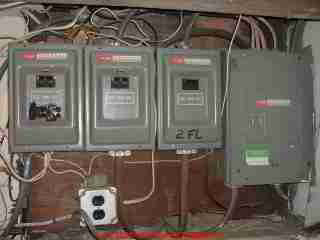 FPE Stab Lok Electric Panel Repair Advice for Home Buyers & Sellers
FPE Stab Lok Electric Panel Repair Advice for Home Buyers & Sellers
- POST a QUESTION or COMMENT about the credibility of FPE Stab-Lok® panel hazards and the need for complete panel replacement, the absence of warranty claims and replacement cost assistance, the absence of a government recall and other FPE risk assessment confusion.
Advice to buyers of a home with an FPE Stab-Lok electrical panel:
This article addresses the occasional claims by parties with conflicting interests, such as home sellers, real estate agents or attorneys representing sellers or other interests who sometimes state that there is no Federal Pacific Electric Stab-Lok® hazard or cite the absence of a final government recall as a reason to assume that no action is justified.
The article also discusses the position of the U.S. homeowners insurance industry on recommending or requiring the replacement of FPE or other obsolete electrical panels in homes and notes that some insurers may require replacement of an FPE panel before issuing a homeowners insurance or fire policy.
We include links to public documents concerning legal and safety issues surrounding this equipment and we link to articles offering FPE panel replacement advice and money-saving alternatives.
InspectAPedia tolerates no conflicts of interest. We have no relationship with advertisers, products, or services discussed at this website.
A summary of the FPE hazard and FPE electrical panel repair / replacement recommendations
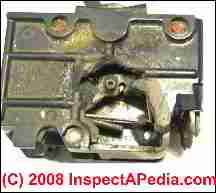 The bottom line on FPE Stab-Lok® equipment: The FPE Stab-Lok® Panel is a latent fire hazard. The panel or its entire bus assembly should be replaced, not simply some or all of the FPE Stab-Lok® circuit breakers.
Replacement cost ranges from $800 to $2000. There is no useful FPE recall, warranty, or other financial relief. See FPE REPLACEMENT PANELS.
The bottom line on FPE Stab-Lok® equipment: The FPE Stab-Lok® Panel is a latent fire hazard. The panel or its entire bus assembly should be replaced, not simply some or all of the FPE Stab-Lok® circuit breakers.
Replacement cost ranges from $800 to $2000. There is no useful FPE recall, warranty, or other financial relief. See FPE REPLACEMENT PANELS.
Making printed copies of this document is permitted. Electronic reproduction or copying of our website pages and articles in any other form is prohibited, with this exception: we provide FPE Stab-Lok® Hazard Summary Page for Public Use that can be freely copied in print or electronic form and that can be copied (without modification) to other websites.
This Federal Pacific Electric Stab-Lok® Electrical Panel replacement advice discusses the real hazards of FPE Electric Stab Lok panels and FPE circuit breakers.
Home buyers and home inspectors who encounter a difference of opinion about FPE Stab-Lok® equipment expressed by a home seller, seller's attorney, or real estate agent, sometimes report the view that because there was no US Government recall of FPE Stab-Lok® electrical panels, there is no concern regarding that equipment.
- The hazard:
FPE Stab-Lok® circuit breakers fail to trip - a fire risk
The articles and field reports at FEDERAL PACIFIC FPE HAZARDS are from neutral party experts, electricians, and home owners who make clear that the FPE Stab-Lok® circuit breaker and panel hazard is a serious but latent fire hazard..
"Latent hazard" means, simply having an FPE Stab-Lok® electrical panel in a home does not itself initiate a failure or fire.
The problem is that FPE breakers often don't trip when they should in order to prevent a fire - at a failure rate of up to 60 % of the time - a much higher failure rate than most other circuit breakers. - References that support this conclusion are at FPE Stab-Lok® HAZARDS & REPAIRS WEBSITE
- Conflicts of interest: OPINION: people who assert that this product is not a concern are speaking from a position of conflicting interest (wanting to sell a house for the most profit, or wanting to protect corporate assets from liability claims). This viewpoint does not include a concern for the safety of the next occupants of a building served by an FPE Stab-Lok® electrical panel.
Do not rely on electrical panel age as a guarantee of safety
Do not rely on electrical panel age, nor on an "inspection" by an electrician or home inspector or building inspector as "proof" that the electrical panel is or is not as safe and reliable as other brands. Don't rely on a home owner, seller, real estate agent, or anyone else who says "it's been fine so far" either.
FACT: Saying that an FPE Stab-Lok® panel has "performed just fine up to now" is not a reliable indicator of its safety.
OPINION: If you are never in an auto crash the fact that your seatbelt is hanging by a thread will never be noticed.
What if the FPE Panel Looks OK and No Problems Have Occurred in a Particular Home?
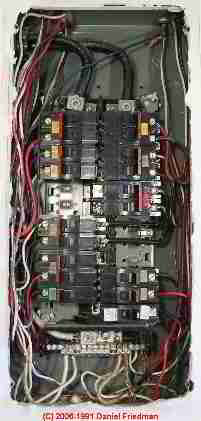
What if up to now there has been no evidence of a "failure" in a home serviced by a Federal Pacific Electric Stab-Lok® electrical panel?
If you haven't seen FPE failures yourself (a sample of "one" is not statistically meaningful), instead see FPE FAILURE FIRE PHOTOS which is a collection of field failure reports, fires, overheats, and FPE problems which has over 130 entries (and more on file waiting to be entered).
In the Federal Pacific Electric Stab-Lok® ™ panel bus assembly shown here, the equipment "looked fine" to the home inspector, home owner, home buyer, real estate agent, and everyone else, until the licensed electrician, someone familiar with FPE failures, removed a few circuit breakers to show the burning bus-to-breaker connections in the electrical panel.
Considering that only 2% to 5% of electrical failures are ever reported to any collecting authority, this is significant data.
Why have some homes with FPE Stab-Lok® breakers & panels "never seen a problem"?
Past history is no promise of future: Statements about this equipment by an owner or realtor that "there has never been a problem in this building" are not a safe
predictor of what can happen in the future. It may simply be the case that the circuit breakers have not been called-on to
respond to an overload condition. An overcurrent or short circuit - hazards against which circuit breakers are designed to protect the home and its occupants - may not have occurred at a particular property.
If no electrical circuit in the building ever has had a reason to trip a circuit breaker, no one will have ever
seen the "FPE no-trip" problem. But when one of these breakers should trip to turn off power to prevent a fire,
there is a significant t chance that it won't.
Federal Pacific Electric Panel Recalls - FPE Stab-Lok® Recalls
If you are looking for a federal recall notice you won't find it.
Although Federal Pacific Electric lost it's UL listing for a time, it subsequently went out of business. There was no product recall issued in the U.S. (There was a product recall of some Canadian products under the Federal Pioneer brand version of this panel.)
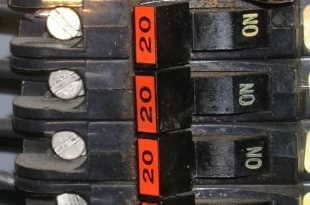 Instead of relying on the presence or absence of a government-ordered product recall, in this case we suggest reading the test data cited at the FPE Stab-Lok® information website,
the court findings of fraud by FPE, and the many field reports of failures and even fires.
The FPE hazard is real, well defined, and unambiguous.
Instead of relying on the presence or absence of a government-ordered product recall, in this case we suggest reading the test data cited at the FPE Stab-Lok® information website,
the court findings of fraud by FPE, and the many field reports of failures and even fires.
The FPE hazard is real, well defined, and unambiguous.
The absence of a recall of FPE Stab-Lok® electrical panels does not mean the absence of a problem. Aluminum wiring is a recognized fire hazard but was never "recalled".
Do not waste time looking for an FPE product recall, FPE warranty claim, or FPE panel replacement money: there isn't any except for
a successful class action lawsuit that affects some New Jersey homeowners and an older Federal Pioneer (same product
different label) recall for some Canadian equipment. FPE and FP product recalls are discussed further below.
Extensive independent tests as well as field incident reports confirm that having a Stab-Lok® electrical panel is
similar to the risk of having put a penny in a fuse socket instead of a fuse.
The FPE Stab-Lok® photograph shown here is an example of a circuit breaker which failed with an arcing incident sufficient to burn out and blow out the side of the circuit breaker case. Pennies in fuse sockets are a recognized electrical fire hazard but have never been specifically addressed by recall nor by explicit legislation.
OPINION: Relying on a product recall is like believing that there is no crime because we have police departments or believing that there are no auto accidents because cars have brakes. There can be real hazards without a recall. There has been no recall of pennies put in fuse sockets, for example.
How to identify FPE Stab-Lok® Electrical Equipment
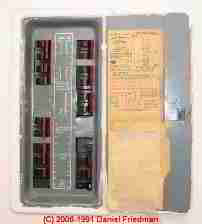
Federal Pacific Electric Stab-Lok® (TM) panels and breakers are easily identified by markings on the panel front face (inside the door), writing on paper labels that may glued to the inside of the panel cover or inside the panel enclosure, the appearance of the circuit breakers, and unique appearance of the panel bus design (that breakers are plugged into).
Some of these details can be observed safely only by a licensed electrician who can remove circuit breakers but most of them are easily observed by a homeowner.
See HOW TO IDENTIFY FPE & FP for help on how to identify or recognize Federal Pacific Electric FPE Stab Lok circuit breakers and electrical panels - Product Identification photos and advice" helps identify Federal Pacific Electric Stab-Lok® equipment.
Federal Pacific Electric Stab Lok Panels Should Be Replaced not "Repaired"
Watch out: we advise against purchasing replacement FPE Federal Pacific Electric Stab-Lok® circuit breakers or panel parts. Data indicates that these replacement parts do not perform more safely than old or original FPE parts, and other innate safety concerns with the panel and bus assembly also would remain in place. The FPE Stab-Lok® electrical panel and its part should be replaced entirely.
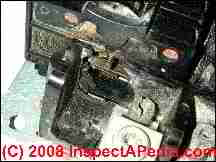
Do not just replace the FPE circuit breakers, and do not install substitute or "replacement" FPE breakers that "fit" in the panel. We have yet to be supplied with independent test data indicating that these new breakers perform any better than the originals, and we have received field reports of failures and burn-ups with "new" and "replacement" FPE breakers.
Furthermore, there are FPE panel bus, bus-to-breaker connections, and panel connection problems that appear to contribute to panel and breaker failures.
Replace the Panel If the electrical panel or circuit breakers are identified as Federal Pacific Electric or "Stab Lok" the electrical panel should be replaced and a new panel with new breakers installed. The FPE REPLACEMENT PANELS link at the ARTICLE INDEX the bottom of this article offers some alternatives and can save you some money.
The FPE Stab-Lok® electrical panel should be replaced. No new breakers, no inspections, no tests. Replaced.
Who should pay for replacement of a Federal Pacific Electric Company Stab-Lok® Panel?
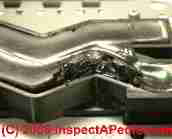
Don't look to the government: We know of no meaningful program offered by any company nor government agency which provides financial assistance for the replacement of this unsafe electrical panel.
This FPE photograph is of the backside of the electrical panel bus assembly where an overheating condition and "meltdown" are occurring. This damage could not be seen unless the panel is taken out of the enclosure.
So who pays?: Home buyers and some home sellers often ask us who should pay for replacement of this unsafe electrical panel. Our opinion is that the panel is unsafe and should be replaced, but we are a neutral party with regard to who should pay for this repair.
Payment or allowance for addressing any substantive defect discovered at a property being purchased is a matter for negotiation between the parties, with advice from their attorney and real estate agent.
What does it cost?: Typical installation of a new 100-Amp electrical panel in the U.S. ranges from $900. to $2800. including parts and labor - not significant as a portion of value of a home. Some replacement methods (steel panel enclosure reuse) may reduce that cost in some cases..
Working in a tight space, installing a higher ampacity electrical panel, or other considerations might push this cost up closer to that higher $2800. figure. The cost of replacing an FPE Stab-Lok® panel can sometimes be reduced if the electrician agrees that it is suitable to re-use the original steel panel enclosure, inserting a new bus assembly and breakers, because the labor of rerouting wires is eliminated.
That option is suitable only if the service size and thus the panel enclosure size is large enough to meet modern requirements.
See REPLACEMENT PANELS.
OPINION: It is unfortunate when a building seller, real estate agent, or their attorney put the safety of future occupants of a building at risk by attempting to head off negotiation on this particular defect by asserting that there is no hazard. The risks are well documented by both field reports and independent lab testing.
The cost to cure this common building defect is quite small compared with the value or purchase price of almost any building. An owner or real estate agent who is informed about this safety hazard and who fails to disclose this condition to another future buyer may be liable for real estate fraud as well as for any ensuing loss.
Because the safety of the future occupants of the building as well as the building itself are at risk, the new owner should assure that the panel is replaced, regardless of who pays for it. If the building is not being sold, certainly the current owner should have this safety hazard corrected promptly.
- Who pays for the replacement electrical panel? We are a neutral party concerning who pays (buyer or seller of a property) but we suggest that the panel should be replaced promptly.
Our opinion is that a building seller is not required by state or federal law to fix anything and in fact could be assuming liability by doing so. However some lenders or insurance companies may require that certain safety or other building defects be repaired before issuing a mortgage or an insurance policy.
Our opinion is that similarly, a seller is not obligated to discount their property because of the need for an electrical panel replacement - that's something that is negotiable between buyer and seller.
But if a seller agrees to assume all or part of the cost of repairing a building defect in the building being sold, there are some reasons why it's better to give the buyer a fair allowance than for the seller to actually perform the work. By making an allowance to the buyer for the repair of an agreed-on defect:
- The seller puts the buyer in control of the repair, permitting the buyer to have confidence that the work was done to their satisfaction, with no short-cuts.
- The buyer may be able to combine the needed repair with other elective repairs or property improvements (such as installing a larger ampacity electrical panel than the old one that was removed), thus saving money.
- This step also relieves the seller of responsibility for the work having been performed correctly.
It is important that any buyer be accurately informed lest the seller leave them with an unrecognized hazard in the building. In at least some states in the U.S. a seller or real estate agent who does not disclose a known, substantive property defect to a buyer could be liable for charges of fraud.
The cost of a new electrical panel is such a small portion of the value of a building that the need to replace the panel is not a reason to refuse to buy the building just as the need to repair automobile brakes is not, alone, a reason to refuse to buy a used car.
Do Homeowners' Insurance Policy Issuers such as State Farm Insurance Require a Home Buyer to Replace an FPE Federal Pacific Electrical Panel?
OPINION
If you're asking about the size of an issue of denial of home owners' insurance because of the presence of an FPE panel in a home in the U.S., we don't have a quantitative answer but think it is probably only of modest impact.
There is no question that the FPE hazard is real; when a particular breaker brand can fail to trip as much as 60% of the time and 100% of the time after an overload on one leg of a two pole breaker, that's enormously worse performance than the industry where such failures in general are down in the .02% range. It's fair to note that there are other problem brands of panel and breaker too, perhaps with similarly high failure rates, but that have not been adequately studied, such as Zinsco, Challenger, &c.
Some readers and home inspection clients have reported that their insurance company denied a homeowners policy until or made it conditional on replacement of the FPE panel. (Interesting that they don't do that for proper aluminum wiring repair - eh?). Among those companies is State Farm, the largest insurer of homes in the U.S. since 1964. Other insurance companies have been named as having a similar policy.
Watch out: other online postings about the insurance industry's position on FPE or other unsafe or obsolete electrical panels offer dangerous advice such as "have the panel inspected by an electrician".
The problem with this approach is that although visual inspection might disclose burned or damaged electrical panel components, visual inspection cannot detect latent hazards such as a breaker that is likely to fail to trip when subjected to an overcurrent.
And in-place testing is dangerous too, risking a fire in the home or causing a breaker to fail later. "Testing" a two -pole FPE breaker by putting an overcurrent on one leg is very likely to cause it to jam and fail to trip in the future, causing a near 100% failure rate. An electrician cannot correctly pronounce an FPE panel as "safe" and is not going to accept responsibility for a later failure or loss.
What limits the scope or impact of of insurance company denial of coverage until an FPE or other electrical panel is replaced includes at least two facts: inconsistent policy denial policy within State Farm and other companies, and the comparatively low cost of the proper repair.
- When we last looked at this question in detail (2012), some clients and readers reported that the State Farm and other insurance company policies on Federal Pacific Electric (FPE) panel replacement was not being enforced nationally.
Rather the decision to write a policy or not was decided locally. As there are thousands of local State Farm offices issuing policies, whether an individual home buyer meets this objection is hit or miss. It appears that most offices don't consider the panel brand nor other specific-brand problem components in homes but offices that have run into a claim do consider them. - The cost to replace an electrical panel in a typical home in the U.S. is a small fraction of the purchase price.
With an average U.S. home selling price of about $379,800, or a median home selling price of $321,100 (April 2016), allowing a steep $2000 cost for a new electrical panel, that repair is 1/2 of 1% of the home value or less. It's not a big enough expense that it should be a stumbling block in the purchase of a home. - "Median and Average Sales PRices of New Homes Sold in the United States, https://www.census.gov/construction/nrs/pdf/uspricemon.pdf
Existing home prices were a bit less, about $233,000 (April 2016), still we're looking at less than 1% of the home's selling price as the cost to replace an electrical panel. - https://ycharts.com/indicators/sales_price_of_existing_homes
Yet some buyers and sellers balk at any expense or find it a reason to argue and negotiate. The conversion of a small but justified home repair cost into a topic of negotiation and delay is largely emotionally based and may involve buyers' remorse, anxiety, or other factors.
State Farm does not have a publicly available national policy on replacing specific brands of electrical panels but does note "out of date" equipment.
https://learningcenter.statefarm.com/safety-2/home-1/help-prevent-electrical-fires-at-home/
Stack Exchange has a posting by Grasper cites a State Farm advisory to replace FPE
http://diy.stackexchange.com/questions/44954/fpe-panels-replaced
DIY Chat room has a posting by user AARPY citing State Farm Advice to replace FPE
Originally Posted by AArpy View Post
No doc. Stopped in local ins office to insure a cottage in finger lakes. Am only repeating what I was told by a State Farm Agent. "Under no conditions will we insure a property with these breakers unless you get in writing etc,etc"
http://www.diychatroom.com/f18/fpe-panel-violation-71883/index2/
Angie's list notes the question; one poster notes that their insurance company advised having their FPE "inspected" - which as we know is a bad idea
https://www.angieslist.com/articles/are-federal-pacific-circuit-breaker-panels-safe.htm
INACHI has posted a thread on this at
https://www.nachi.org/forum/f19/federal-pacific-panels-7079/
among some posters the ignorance about FPE and even who owns what brand is stunning - but no specific insurance company was named.
...
Continue reading at FPE REPLACEMENT PANEL or select a topic from the closely-related articles below, or see the complete ARTICLE INDEX.
Or see these
Recommended Articles
- ELECTRICIANS List of Electricians familiar w/ FPE
- FEDERAL PACIFIC FPE HAZARDS - home
- FEDERAL PIONEER PANEL SAFETY
- SUMMARY of the FPE Stab-Lok® HAZARD
Suggested citation for this web page
FPE PANEL ADVICE for HOME BUYERS at InspectApedia.com - online encyclopedia of building & environmental inspection, testing, diagnosis, repair, & problem prevention advice.
Or see this
INDEX to RELATED ARTICLES: ARTICLE INDEX to FPE STAB-LOK BREAKERS & PANELS
Or use the SEARCH BOX found below to Ask a Question or Search InspectApedia
Ask a Question or Search InspectApedia
Questions & answers or comments about the credibility of FPE Stab-Lok® panel hazards and the need for complete panel replacement, the absence of warranty claims and replacement cost assistance, the absence of a government recall and other FPE risk assessment confusion..
Try the search box just below, or if you prefer, post a question or comment in the Comments box below and we will respond promptly.
Search the InspectApedia website
Note: appearance of your Comment below may be delayed: if your comment contains an image, photograph, web link, or text that looks to the software as if it might be a web link, your posting will appear after it has been approved by a moderator. Apologies for the delay.
Only one image can be added per comment but you can post as many comments, and therefore images, as you like.
You will not receive a notification when a response to your question has been posted.
Please bookmark this page to make it easy for you to check back for our response.
Our Comment Box is provided by Countable Web Productions countable.ca
Citations & References
In addition to any citations in the article above, a full list is available on request.
- Thanks to reader Daniel Smead for helpful detailed editing May 2010
- Ampacity of an Electrical Service: How to determine the electrical service size or ampacity entering a building
- Circuit Breaker, a bad one fails to trip failure at aluminum bus-to-circuit breaker connection - field report and photographs
- Electrical System & Wiring Hazard Inspection, Detection, Cause, Remedy, Prevention - Main Electrical Page
- Electrical Panels, How to Inspect in buildings, safety for electrical inspectors, electrical panel, fusing, wiring defects, defective products. Inspection Class Presentation
- The Federal Pacific Stab-Lok® Electric Panel Hazard Website Safety Information for Consumers.
- 2007 FPE Stab-Lok® TECHNICAL REPORT - an updated test report of independent testing (a large 1.2MB PDF file) using a larger pool of FPE Stab-Lok® circuit breakers than the older CPSC and Wright Malta tests found significantly higher failure rates of FPE Stab-Lok® circuit breakers, including a look at critical safety failures (breaker failed to trip at 200% of rated current or jammed) which found up to 80% failure rate for FPE Stab-Lok® GFCI circuit breakers (n=4), 12% failure rate for double pole FPE Stab-Lok® circuit breakers (n=120), and a 1% failure rate for FPE Stab-Lok® single pole circuit breakers (n=345).
- FPE FIRES: Failures continue: FPE breaker fails, results in fires: field reports
- Federal Pacific Electric Fires Waiting to Happen, Debate Waiting to Be Ended, detailed article
- Home Inspection Reporting Language and discussion for FPE panels
- How to Identify FPE Federal Pacific Stab-Lok® Electric Panels - is yours one of these? ALSO: A History of the FPE Stab-Lok® Issue.
- Replacement Circuit Breakers for FPE Stab-Lok® Electric Panels? are not recommended
- Replacement Panels for FPE Stab-Lok® load centers - options include conventional complete panel replacement and a less costly replacement of the panel interior load center/bus assembly
- In addition to citations & references found in this article, see the research citations given at the end of the related articles found at our suggested
CONTINUE READING or RECOMMENDED ARTICLES.
- Carson, Dunlop & Associates Ltd., 120 Carlton Street Suite 407, Toronto ON M5A 4K2. Tel: (416) 964-9415 1-800-268-7070 Email: info@carsondunlop.com. Alan Carson is a past president of ASHI, the American Society of Home Inspectors.
Thanks to Alan Carson and Bob Dunlop, for permission for InspectAPedia to use text excerpts from The HOME REFERENCE BOOK - the Encyclopedia of Homes and to use illustrations from The ILLUSTRATED HOME .
Carson Dunlop Associates provides extensive home inspection education and report writing material. In gratitude we provide links to tsome Carson Dunlop Associates products and services.

